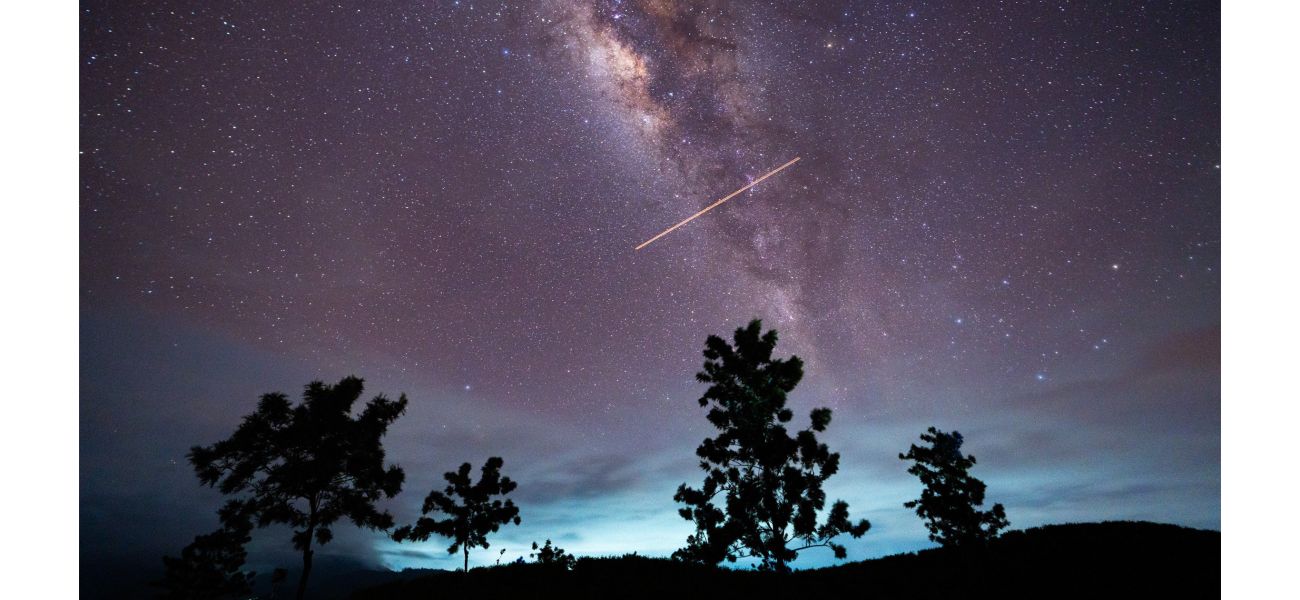When can you see the Draconid meteor shower and where?
Tonight's meteor shower peak can be seen without equipment, but how, where and when?
October 8th 2024.

Are you ready for a spectacular show in the night sky? Look up, because October is known for some of the most active and visually stunning meteor showers. If you happen to have a clear sky tonight, you might be lucky enough to witness one of the most magnificent meteor displays of the year. The Draconid meteor shower is expected to reach its peak tonight as Earth passes through a cloud of debris left behind by a comet. This shower is also known as the Giacobinids, named after Michel Giacobini who discovered the comet 21 P/Giacobini-Zinner, the source of these meteors.
Despite their tiny size, as small as a grain of sand, these particles can still put on a breathtaking show. While there is a chance of seeing them from Sunday to Thursday this week in the Northern Hemisphere, the peak is expected to be between Tuesday and Wednesday, which is tonight. Curious about the timing of the Draconid meteor shower? Well, you're in luck! These meteors are some of the easiest to see, as you won't have to stay up late on a school night. Unlike most other meteor showers, which are best seen in the early hours of the morning, the Draconids are best viewed in the evening, after nightfall. So, keep an eye out from around 7pm tonight, but don't worry if you miss it, as you may still be able to catch a glimpse into the early hours.
But before you head out to catch this stunning display, remember to give your eyes about 20 minutes to half an hour to adjust to the darkness. This will give you optimal night vision for the best viewing experience. According to Dr. Minjae Kim, a research fellow from the Department of Physics at the University of Warwick, under ideal conditions, one can witness up to 10 meteors per hour during the peak of the Draconid meteor shower. The radiant point of this shower is highest in the evening sky, making it a rare meteor shower that is best viewed after sunset rather than in the early morning hours. The waxing crescent to first quarter moon phase will provide relatively dark skies, enhancing visibility.
If you're wondering where to go to get the best view of the Draconids, look for areas with minimal light pollution, such as rural settings or parks away from city lights. Make sure you have an unobstructed view of the sky and a clear horizon. You could even bring a reclining chair or a blanket to comfortably observe the sky. Remember, patience is key when it comes to stargazing. So, settle in, relax, and let the wonders of the night sky unfold before you.
But that's not all, there are other meteor showers that will be visible this month as well. Meteor showers occur when space debris enters Earth's atmosphere and burns up, about 62 miles from the ground. The next peak will be the Southern Taurids, which will be most visible between October 10 and 11. This relatively slow and bright shower started around September 10 and will last until November 20, but with a rate of just five an hour, you might have to wait a while before one appears in the sky. Another fragment of the same debris cloud, the Northern Taurids, will be visible from the end of the month, peaking in the middle of November.
Did you know that shooting stars can travel at speeds of tens of thousands of miles per hour? The Orionids meteor system, made up of dust from Halley's Comet, will also be visible this month. Although we won't see Halley's Comet itself until 2061, the Orionids will still put on a show. Their maximum will be around October 21 and 22, although they have been visible since this week. These fast-moving meteors with fine trains fly overhead at a rate of 25 an hour, making them the most reliable bet if you want to venture out to look at the night sky. You have until November 7 to catch a glimpse as they fly through the atmosphere at speeds of 41 miles per second.
Now, the question is, where is the best place to watch these meteor showers? Well, darkness is your friend when it comes to searching for comets or meteors. According to the Royal Observatory Greenwich, "Hunting for meteors, like the rest of astronomy, is a waiting game." So, make sure to bring a comfy chair to sit on and to wrap up warm, as you could be outside for a while. The best spot is somewhere with a clear view of the stars, with very little light pollution. You'll have better luck on Ben Nevis than Primrose Hill, but there's always a happy medium. Just hope for clear weather, as cloudy skies can obstruct your view of the night sky.
The Royal Observatory suggests avoiding direct sources of light in your eyes, so that you can fully adapt to the local conditions and ensure that fainter meteors become visible. They also advise against using binoculars or a telescope, as you should take in the widest possible view of the sky. So, grab a comfortable spot, sit back, and let the magic of the night sky unfold before you.
So, don't miss out on these spectacular meteor showers happening this month. Get ready to witness the beauty and wonder of these shooting stars and make sure to mark your calendars for the next peak. Happy stargazing!
Despite their tiny size, as small as a grain of sand, these particles can still put on a breathtaking show. While there is a chance of seeing them from Sunday to Thursday this week in the Northern Hemisphere, the peak is expected to be between Tuesday and Wednesday, which is tonight. Curious about the timing of the Draconid meteor shower? Well, you're in luck! These meteors are some of the easiest to see, as you won't have to stay up late on a school night. Unlike most other meteor showers, which are best seen in the early hours of the morning, the Draconids are best viewed in the evening, after nightfall. So, keep an eye out from around 7pm tonight, but don't worry if you miss it, as you may still be able to catch a glimpse into the early hours.
But before you head out to catch this stunning display, remember to give your eyes about 20 minutes to half an hour to adjust to the darkness. This will give you optimal night vision for the best viewing experience. According to Dr. Minjae Kim, a research fellow from the Department of Physics at the University of Warwick, under ideal conditions, one can witness up to 10 meteors per hour during the peak of the Draconid meteor shower. The radiant point of this shower is highest in the evening sky, making it a rare meteor shower that is best viewed after sunset rather than in the early morning hours. The waxing crescent to first quarter moon phase will provide relatively dark skies, enhancing visibility.
If you're wondering where to go to get the best view of the Draconids, look for areas with minimal light pollution, such as rural settings or parks away from city lights. Make sure you have an unobstructed view of the sky and a clear horizon. You could even bring a reclining chair or a blanket to comfortably observe the sky. Remember, patience is key when it comes to stargazing. So, settle in, relax, and let the wonders of the night sky unfold before you.
But that's not all, there are other meteor showers that will be visible this month as well. Meteor showers occur when space debris enters Earth's atmosphere and burns up, about 62 miles from the ground. The next peak will be the Southern Taurids, which will be most visible between October 10 and 11. This relatively slow and bright shower started around September 10 and will last until November 20, but with a rate of just five an hour, you might have to wait a while before one appears in the sky. Another fragment of the same debris cloud, the Northern Taurids, will be visible from the end of the month, peaking in the middle of November.
Did you know that shooting stars can travel at speeds of tens of thousands of miles per hour? The Orionids meteor system, made up of dust from Halley's Comet, will also be visible this month. Although we won't see Halley's Comet itself until 2061, the Orionids will still put on a show. Their maximum will be around October 21 and 22, although they have been visible since this week. These fast-moving meteors with fine trains fly overhead at a rate of 25 an hour, making them the most reliable bet if you want to venture out to look at the night sky. You have until November 7 to catch a glimpse as they fly through the atmosphere at speeds of 41 miles per second.
Now, the question is, where is the best place to watch these meteor showers? Well, darkness is your friend when it comes to searching for comets or meteors. According to the Royal Observatory Greenwich, "Hunting for meteors, like the rest of astronomy, is a waiting game." So, make sure to bring a comfy chair to sit on and to wrap up warm, as you could be outside for a while. The best spot is somewhere with a clear view of the stars, with very little light pollution. You'll have better luck on Ben Nevis than Primrose Hill, but there's always a happy medium. Just hope for clear weather, as cloudy skies can obstruct your view of the night sky.
The Royal Observatory suggests avoiding direct sources of light in your eyes, so that you can fully adapt to the local conditions and ensure that fainter meteors become visible. They also advise against using binoculars or a telescope, as you should take in the widest possible view of the sky. So, grab a comfortable spot, sit back, and let the magic of the night sky unfold before you.
So, don't miss out on these spectacular meteor showers happening this month. Get ready to witness the beauty and wonder of these shooting stars and make sure to mark your calendars for the next peak. Happy stargazing!
[This article has been trending online recently and has been generated with AI. Your feed is customized.]
[Generative AI is experimental.]
0
0
Submit Comment





